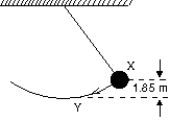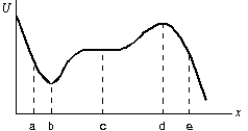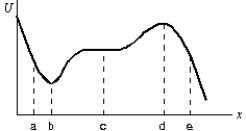A) AB, BC, CD
B) AB, CD, BC
C) BC, CD, AB
D) BC, AB, CD
E) CD, BC, AB
G) A) and E)
Correct Answer

verified
Correct Answer
verified
Multiple Choice
A force of 10 N holds an ideal spring with a 20-N/m spring constant in compression. The potential energy stored in the spring is:
A) 0.5 J
B) 2.5 J
C) 5 J
D) 10 J
E) 200 J
G) B) and E)
Correct Answer

verified
Correct Answer
verified
Multiple Choice
A block of mass m is initially moving to the right on a horizontal frictionless surface at a speed v. It then compresses a spring of spring constant k. At the instant when the kinetic energy of the block is equal to the potential energy of the spring, the spring is compressed a distance of:
A) ![]()
B) (1/2) mv2
C) (1/4) mv2
D) mv2/4k
E) ![]()
G) B) and D)
Correct Answer

verified
Correct Answer
verified
Multiple Choice
The sum of the kinetic and potential energies of a system of objects is conserved:
A) only when no external force acts on the objects
B) only when the objects move along closed paths
C) only when the work done by the resultant external force is zero
D) always
E) none of the above
G) A) and C)
Correct Answer

verified
Correct Answer
verified
Multiple Choice
A projectile of mass 0.50 kg is fired with an initial speed of 10 m/s at an angle of 60 ° above the horizontal. The potential energy of the projectile-Earth system when the projectile is at its highest point (relative to the potential energy when the projectile is at ground level) is:
A) 25 J
B) 18.75 J
C) 12.5 J
D) 6.25 J
E) none of these
G) B) and E)
Correct Answer

verified
Correct Answer
verified
Multiple Choice
A particle is released from rest at the point x = a and moves along the x axis subject to the potential energy function U(x) shown. The particle: 
A) moves to a point to the left of x = e, stops and remains at rest
B) moves to a point to x = e, then moves to the left
C) moves to infinity at varying speed
D) moves to x = b where it remains at rest
E) moves to x = e and then to x = d, where it remains at rest
G) B) and C)
Correct Answer

verified
Correct Answer
verified
Multiple Choice
The potential energy for the interaction between the two atoms in a diatomic molecule is U = A/x12 - B/x6, where A and B are constants and x is the interatomic distance. The magnitude of the force of one atom exerts on the other is: 
A) 12A/|x|13 - 6B/|x|7
B) -13A/|x|13 + 7B/|x|7
C) -11A/|x|11 + 5B/|x|5
D) 72A/|x|12 - 72B/|x|6
E) A/|x|13 - B/|x|7
G) A) and E)
Correct Answer

verified
Correct Answer
verified
Multiple Choice
A 0.50-kg block attached to an ideal spring with a spring constant of 80 N/m oscillates on a horizontal frictionless surface. The total mechanical energy is 0.12 J. The greatest speed of the block is:
A) 0.15 m/s
B) 0.24 m/s
C) 0.49 m/s
D) 0.69 m/s
E) 1.46 m/s
G) A) and E)
Correct Answer

verified
Correct Answer
verified
Multiple Choice
Objects A and B interact with each other via both conservative and nonconservative forces. Let KA and KB be the kinetic energies, U be the potential energy, and Eint be the internal energy. If no external agent does work on the objects then:
A) KA + U is conserved
B) KA + U + Eint is conserved
C) KA + KB + Eint is conserved
D) KA + KB + U is conserved
E) KA + KB + U + Eint is conserved
G) None of the above
Correct Answer

verified
Correct Answer
verified
Multiple Choice
A simple pendulum consists of a 2.0 kg mass attached to a string. It is released from rest at X as shown. Its speed at the lowest point Y is: 
A) 0.90 m/s
B) ![]()
C) 3.6 m/s
D) 6.0 m/s
E) 36 m/s
G) B) and C)
Correct Answer

verified
Correct Answer
verified
Multiple Choice
The diagram shows a plot of the potential energy as a function of x for a particle moving along the x axis. The points of stable equilibrium are: 
A) only a
B) only b
C) only c
D) only d
E) b and d
G) A) and B)
Correct Answer

verified
Correct Answer
verified
Multiple Choice
A golf ball is struck by a golf club and falls on a green eight feet above the tee. The potential energy of the Earth-ball system is greatest:
A) just before the ball is struck
B) just after the ball is struck
C) just after the ball lands on the green
D) when the ball comes to rest on the green
E) when the ball reaches the highest point in its flight
G) All of the above
Correct Answer

verified
Correct Answer
verified
Multiple Choice
A small object of mass m, on the end of a light cord, is held horizontally at a distance r from a fixed support as shown. The object is then released. What is the in the cord when the object is at the lowest point of its swing? 
A) mg/2
B) mg
C) 2 mg
D) 3 mg
E) mgr
G) B) and E)
Correct Answer

verified
Correct Answer
verified
Multiple Choice
The potential energy of a particle moving along the x axis is given by U(x) = (8.0J/m2) x2 + (2.0J/m4) x4. If the total mechanical energy is 9.0 J, the limits of motion are:
A) -0.96 m; +0.96 m
B) -2.2 m; +2.2 m
C) -1.6 m; +1.6 m
D) -0.96 m; +2.2 m
E) -0.96 m; +1.6 m
G) A) and D)
Correct Answer

verified
Correct Answer
verified
Multiple Choice
The diagram shows a plot of the potential energy as a function of x for a particle moving along the x axis. The points of neutral equilibrium are: 
A) only a
B) only b
C) only c
D) only d
E) b and d
G) None of the above
Correct Answer

verified
Correct Answer
verified
Multiple Choice
A 0.5-kg block slides along a horizontal frictionless surface at 2 m/s. It is brought to rest by compressing a very long spring of spring constant 800 N/m. The maximum spring compression is:
A) 0 cm
B) 3 cm
C) 5 cm
D) 80 cm
E) 80 m
G) A) and B)
Correct Answer

verified
Correct Answer
verified
Multiple Choice
The long pendulum shown is drawn aside until the ball has risen 0.5 m. It is then given an initial speed of 3.0 m/s.. The speed of the ball at its lowest position is: 
A) zero
B) 0.89 m/s
C) 3.1 m/s
D) 3.7 m/s
E) 4.3 m/s
G) A) and E)
Correct Answer

verified
Correct Answer
verified
Multiple Choice
The diagram shows a plot of the potential energy as a function of x for a particle moving along the x axis. The points of unstable equilibrium are: 
A) only a
B) only b
C) only c
D) only d
E) b and d
G) C) and D)
Correct Answer

verified
Correct Answer
verified
Multiple Choice
A 700-N man jumps out of a window into a fire net 10 m below. The net stretches 2 m before bringing the man to rest and tossing him back into the air. The maximum potential energy of the net, compared to it's unstretched potential energy, is:
A) 300 J
B) 710 J
C) 850 J
D) 7000 J
E) 8400 J
G) C) and D)
Correct Answer

verified
Correct Answer
verified
Multiple Choice
Three identical blocks move either on a horizontal surface, up a plane, or down a plane, as shown below. They all start with the same speed and continue to move until brought to rest by friction. Rank the three situations according to the mechanical energy dissipated by friction, least to greatest. 
A) The same for all cases
B) 1, 2, 3
C) 1, then 2 and 3 tie
D) 3, 2, 1
E) 2, 1, 3
G) B) and C)
Correct Answer

verified
Correct Answer
verified
Showing 41 - 60 of 61
Related Exams